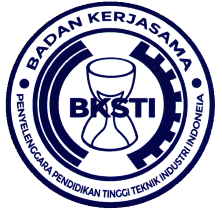Analisis Persediaan Produk Gula Rafinasi Menggunakan Metode Economic Production Quantity
DOI:
https://doi.org/10.52759/inventory.v2i1.33Keywords:
Economic Production Quantity, Optimal Solution, Total Inventory Cost, Sensitivity AnalysisAbstract
Overload is a condition where the goods stored in the warehouse exceed the existing capacity. With the accumulation, it will increase the storage cost for the products/goods stored. The purpose of this research was to help companies determine the optimal amount of production, optimal production time intervals and maximum product inventory so that there is no excess stock of products in the warehouse, and to obtain a minimum total inventory cost by using the Economic Production Quantity (EPQ) model. To collect the data needed in this study, secondary data was used which consists of production data and product delivery of company X. From the research results, the optimal production rate (Q*) is 13,646 MT/production cycle with an optimal production time interval of 1.16 months. or equal to 35 days, the maximum amount of inventory (Imax) was 429 MT. The total minimum inventory cost in one production cycle/month is Rp.167,925,698.28, -. The difference in total inventory costs generated using the EPQ method and calculations based on company conditions is 9% or equivalent to Rp.16,538,501, -. Based on the results of the sensitivity analysis it was known that all parameters are sensitive to Q*, Imax, and total inventory costs. However, a significant change is the parameter of saving costs, where the increase and decrease in saving costs will decrease and increase Q*, Imax, and the total cost of inventory
Downloads
References
D. Tresna Ayu, “Analisis Pengedalian Tingkat Produksi Optimal Crumb Rubber Dengan Metode Economic Production Quantity (EPQ)(Studi Kasus : PT. Perkebunan Nusantara III Medan),” North Sumatera University, Medan, North Sumatera, Indonesi, 2018.
N. P. F. Sayuni, A. Zukhri, and M. A. Meitriana, “Analisis Jumlah Produksi Optimal Dengan Metode Economic Production Quantity ( EPQ ) Pada Ud . Sinar Abadi Singaraja,” vol. 00, no. 3, 2014.
F. Putri, “Analisis Produksi Optimal Pengolahan Kopi Salak dengan Model Economic Production Quantity Pada UD . Salacca Padangsidimpuan,” universitas sumatera utara, 2019.
E. Fibriani, D. Cahyadi, and A. Farid H, “Model Economic Production Quantity (EPQ) dengan Sinkronisasi Demand Kontinu Dan Demand
Diskrit pada Produksi Kerupuk Ikan Sungai Khas Kalimantan Timur,” JST (Jurnal Sains Ter., vol. 4, no. 1, pp. 1–9, 2018, doi: 10.32487/jst.v4i1.444.
J. E. Beigel, Perencanaan dan Pengendalian Produksi Cetakan Pertama. 1999.
I. T. Christou, Quantitative methods in supply chain management: Models and algorithms, vol. 9780857297. 2012.
A. Narlan and D. T. Juniar, “Statistika dalam Penjas; Aplikasi praktis dalam penelitian pendidikan jasmani.” p. 123, 2018, Accessed:
Oct. 27, 2020. [Online]. Available: https://books.google.com/bookshl=en&lr=&id=esKIDwAAQBAJ&oi=fnd&pg=PR5&dq=Narlan,+A.,+%26+Juniar,+D.+T.+2018.+Statistika+Dalam+Penjas+Aplikasi+Praktis+Dalam+Penelitian+Pendidikan+Jasmani.+Yogyakarta:+Deepublish&ots=YmFeB14ZH0&sig=rxNmoZ21UdAtN7EiEY5028O5T.
S. E. S. Bariran, K. S. M. Sahari, and A. H. Mahlouji, “Developing a Heuristic Robotics Integrated Production Model for Economic Production Quantity in Mass Customization Manufacturing,” in The Malaysia-Japan Model on Technology Partnership, Springer Japan,
, pp. 139–146.
“Herjanto, E. 2006. Manajemen Operasi (Vol. Edisi... - Google Scholar.” https://scholar.google.com/scholar?hl=en&as_sdt=0%2C5&q=Herjanto%2C+E.+2006.+Manajemen+Operasi+%28Vol.+Edisi+Ketiga%29.+Jakarta%3A+Grasindo&btnG= (accessed Oct. 27, 2020).
S. D. . Dewi, N. K. Tastrawati, and K. Sari, “Analisis Sensitivitas dalam Optimalisasi Keuntungan Produksi Busana dengan Metode
Simpleks,” J. Mat., vol. 4, no. 2, pp. 90–101, Dec. 2014, Accessed: Nov. 03, 2020. [Online]. Available: https://ocs.unud.ac.id/index.php/jmat/article/view/12553.
R. U. Hurint, M. Z. Ndii, and M. Lobo, “Analisis Sensitivitas Model Epidemi SEIR,” Nat. Sci. J. Sci. Technol., vol. 6, no. 1, pp. 22–28, Mar. 2017, doi: 10.22487/25411969.2017.v6.i1.8076.




